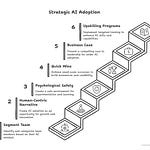For years, we’ve tried to build AI that can solve any problem. A groundbreaking new paper suggests we’ve been tackling it from the wrong angle: “Reinforcement Learning Teachers of Test Time Scaling.” The real path forward isn’t building a genius solver, but a master teacher.
This deep dive breaks down the “Reinforcement-Learned Teacher” (RLT) framework, a strategy that is proving not only more effective, but dramatically more efficient.
Insights
1. Why AI can’t learn what it doesn’t already know
The dominant method for training AI models on reasoning tasks, Reinforcement Learning (RL), has a fundamental chicken-and-egg problem. It relies on rewarding a model for finding the correct answer. But if the model isn’t already capable enough to stumble upon that correct answer, it never receives the reward signal it needs to learn. This “exploration challenge” means traditional RL primarily refines what a model already knows, rather than teaching it something new.
As the research points out:
Sparse rewards cannot yield any learning signal unless the agent is already capable of solving the given task at initialization.
2. The breakthrough: train AI to be a teacher, not a solver
The paper introduces a brilliant solution: Reinforcement-Learned Teachers (RLTs). Instead of giving a model a difficult problem and asking it to explore a vast space of possible solutions, RLTs are given both the problem and the answer. Their task is much simpler and more constrained: generate a clear, step-by-step explanation connecting the two. This reframes the entire challenge from discovery to pedagogy.
The paper states:
RLTs are prompted with both the question and solution to each problem, and tasked to simply “connect-the-dots” with detailed explanations tailored for their students.
3. Aligning the goal with the outcome
A core issue with past approaches has been an “objective mismatch.” The skills an AI develops to find a correct answer on its own are not necessarily the same skills it needs to explain a concept clearly to another AI (a “student” model). The RLT framework fixes this by aligning the teacher’s training objective directly with its ultimate purpose: creating effective teaching material for downstream distillation.
The authors note:
However, the problem-solving skills reinforced by correctness-based rewards have been shown not to be entirely aligned with the goal of downstream distillation.
4. How to grade a teacher: rewarding understanding, not just correctness
So how do you train an AI to be a good teacher? You don’t grade it on whether its student gets the answer right. Instead, you give it a “dense reward” based on how well the student understands the explanation. This is measured by tracking the student model’s confidence in the correct solution as it processes the teacher’s explanation. This provides a continuous stream of feedback, completely avoiding the all-or-nothing problem of traditional RL.
The paper explains:
We train RLTs with dense rewards using the student’s log probabilities to assess its understanding of each problem’s ground-truth solution from the teacher’s explanations...
5. Small but mighty: the power of a specialized teacher
Here’s where it gets truly exciting. The research demonstrated that a relatively small 7-billion-parameter RLT could produce teaching data that resulted in a better-performing student model than data generated by much larger models and then cleaned with complex heuristics. This proves that a smaller, specialized “teacher” AI, trained on the right objective, is more powerful and efficient than simply using a bigger model.
As the authors found:
By distilling students from the raw outputs of a lightweight RLT with 7B parameters, we demonstrate significantly higher performance than using existing pipelines relying on reasoning LMs with orders of magnitude more parameters.
6. When the student becomes stronger than the master
Counter-intuitively, the RLT framework is incredibly effective even when the teacher model is significantly smaller and less powerful than the student model it is teaching. This flips the traditional logic of distillation on its head. It opens up a highly efficient path where small, cheap-to-train teacher models can be used to impart complex reasoning skills to much larger, more capable student models.
The results were clear:
Furthermore, even when distilling a Qwen-32B student, much larger than our 7B teacher, our RLT still outperforms all prior methods...
7. Teaching is a universal skill
One of the most powerful findings is that the ability to explain a known solution is a more generalizable skill than solving a problem from scratch. An RLT trained to teach mathematical reasoning was able to be repurposed, with no additional training, to create effective distillation data for a completely different logic puzzle task. This zero-shot transferability is a game-changer.
Unlike problem-solving from scratch, we posit that providing effective explanations to given solutions is a much less task-specific skill.
In fact, this generalized teacher even outperformed models that were directly trained on the new task, showing just how difficult the “exploration problem” is for traditional RL.
8. What makes a “good” explanation?
A key insight from the framework is that a good explanation isn’t just one that is logically sound from the teacher’s perspective; it must be understandable from the student's perspective. The RLT model is specifically trained to avoid making logical leaps that would be confusing to a student who doesn't already know the answer. The goal is to ensure:
...each step in the logical path traced by the teacher’s explanation to still make sense in the “student’s mind”…
This focus on the student’s viewpoint is critical to effective teaching.
9. Unlocking the latent teacher within
Perhaps most surprisingly, the research suggests that even pre-trained models already possess “latent teaching skills.” Before any specialized RL training, the researchers simply used their new reward function to rank a standard model’s explanations. The highest-ranked explanations alone were enough to produce a high-performing student model. This highlights that the RLT framework isn’t just creating a new skill; it’s unlocking and focusing a potential that already exists.
...even small models already possess latent teaching skills unlocked by our new reward and simplified task formulation.
Takeaways
Rethink your data strategy: Stop focusing solely on datasets of problems and correct answers. The real value may lie in generating high-quality explanations that connect the two. How can you build a pipeline for creating and evaluating didactic, step-by-step data?
Embrace asymmetric distillation: Challenge the assumption that you need a massive model to train a slightly smaller one. A small, specialized, and cost-effective “teacher” model could be the key to unlocking performance in your larger, production-facing models.
Shift from “correctness” to “clarity”: Re-evaluate your internal training and evaluation metrics. Are you rewarding models for simply finding the right answer, or are you rewarding them for producing clear, logical, and understandable reasoning paths that can be used to teach?
Leverage generalist teachers for specialist tasks: For novel or data-scarce domains, don’t immediately default to direct, in-domain training. Consider using a generalized “teacher” model trained on a common-sense domain (like math) to bootstrap performance through high-quality explanations.
The RLT framework paints an exhilarating picture of the path forward. By reframing our goal from creating AI solvers to creating AI teachers, we can unlock a more efficient, scalable, and ultimately more powerful way to build reasoning systems. It feels less like a brute-force engineering challenge and more like a nuanced art of pedagogy, powered by a clever alignment of goals and rewards.
Of course, embracing this new frontier requires a strategic pivot. It means looking beyond the size of our models and focusing intensely on the quality of our training objectives. It’s a call to shift from rewarding outcomes to rewarding the process of explanation itself.
This leads to the essential question you should be asking. Instead of asking, “How can my model solve this problem?”, start asking, “What is the clearest way it could teach the solution?” The answer may unlock the very breakthrough you’re looking for.












Share this post